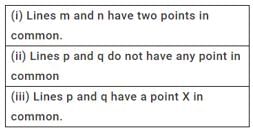Olympiad Test: Practical Geometry - Class 6 MCQ
20 Questions MCQ Test Online MCQ Tests for Class 6 - Olympiad Test: Practical Geometry
Into what type of parts is a figure divided by bisecting it?
Identify the instruments used to bisect a given line segment.
What do you call two lines intersecting at a point?
An angle of 15° is drawn using a pair of compasses and a ruler. How is it done?
Which of the following is an angle that can be constructed using compasses and a ruler?
An angle ∠XYZ = 75∘ is bisected by an angular bisector  . Then what is the measure of∠UYZ?
. Then what is the measure of∠UYZ?
A line segment  is bisected at T. Which of the following equals
is bisected at T. Which of the following equals  ?
?
Which of the following is done to draw an angle of 150∘ using compasses and a ruler?
Two lines are said to be perpendicular to each other when they meet at ____angle.
A perpendicular is drawn to a line segment  at N using a protractor and a point P is marked on it. Which of the following is true?
at N using a protractor and a point P is marked on it. Which of the following is true?
If two lines have only one point in common, what are they called?
For which of the following are the rails of a railway line an example?
A maths teacher asked his students to draw a pair of parallel lines. Which instrument(s) are the students most likely to use?
A few lines in a plane have a point in common. What type of lines can they be?
 is the bisector of ∠PQZ = ∠PQR. Which of the following is true?
is the bisector of ∠PQZ = ∠PQR. Which of the following is true?
The point M on  is such that
is such that  Which of the following is a false statement?
Which of the following is a false statement?
Lines a, b, p, q, m, n and x have a point P common to all of them. What is the name of P?
|
266 tests
|



 has no definite length.
has no definite length.
 such that
such that  bisects
bisects 















